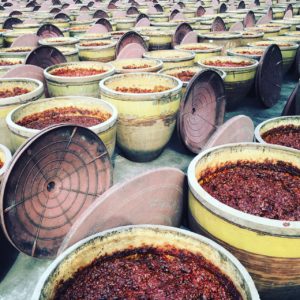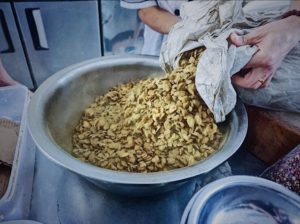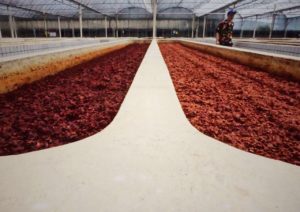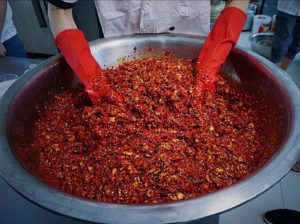Douban: The fermented bean paste the defines Sichuan’s flavors
Douban is the soul of Sichuan food. It does the hard, thankless work of creating the depth of flavor Sichuan is known for. But without getting as much of the credit as its spicier teammates. Douban sets the stage on which the flashier players, like chili peppers and Sichuan peppercorns, catch the spotlight. Douban is the rhythm section of the band driving the flavors of the dish, not the mala guitar solo eveyone talks about when they go home. It gives the base of flavor to everything from hot pot and drypot, to mapo tofu. But it also tastes amazing all by its dark, brooding, umami self, and this is how you need to try it.
Beans, Beans, Beans

Rows of clay jars filled with Douban
Douban jiang is a fermented fava bean and chili paste. It was developed in Sichuan, or more specifically/famously the town of Pixian, just north-west of Chengdu. Legend goes that when Hunanese ‘forced migrants’ were marched to Chengdu, in the ‘Repopulation of Sichuan Program’ they brought beans and chili peppers with them. Long story short, and a little too cute, the damp climate caused them to go bad, but produced unexpectedly delicious results.
There are myriad ways of making douban and even different interpretations of what it is, but they all rely on the same basic steps.
First, fava beans, or broad beans, are fermented until they grow greenish powdery mold. Originally this was done naturally, taking advantage of natural occurring bacterias in the damp region, or by laying them on grain husks that encouraged their development. In some cases flour, would be added to further the development.
Get Cultured

Inoculated Fava Beans
These days the beans are often inoculated with the bacteria directly. This is ultimately a more controllable and safer procedure. After molding, the beans would be washed in baijiu (yep another win for baijiu!) then mixed with fresh minced chilis and A LOT of salt. Originally these were all mixed together in giant earthenware pots. The lids would be removed in the day, to allow the paste to dry and heat up in the sunshine, then covered up at night and mixed every morning. Typically the whole mix needs around a month to ferment enough to be considered douban, but any high quality sauce is fermented for at least a year. Many are fermented for longer, and 3 and 8 yeardoubans are not uncommon. As they age, they become darker, and richer and more pungent, deeper in umami, but less spicy and salty.

Fermentation Pits at a Douban factory
The large factories in Pixian belong to the Pixian Douban Society, a China Time Honored Brand. They are upheld to certain standards and styles to qualify as members. The highly regulated Douban Society, which once had hundreds of brands as members, will forever get increasingly small, and now has only around 70. The majority of these brands don’t ferment in the oldschool clay urns, whose contents must be hand turned every day, but in giant pits churned and mixed by machines. While less romantic, the modern technological adaptations allow companies to be more efficient, produce more douban and ultimately have more control over the final product. The end product is very much the same.
Eat More Douban

To understand the role it plays and work it does, we highly recommend anyone to taste douban, fresh, on its own or even as a dip to understand its flavors and the depth it contributes to the dish. It’s like isolating James Jamerson’s bass lines on ‘Ain’t no Mountain High’ or ‘What’s Going On’. It will change the whole way you listen to the song. Or in this case the symphony of flavors in Sichuan cuisine.

